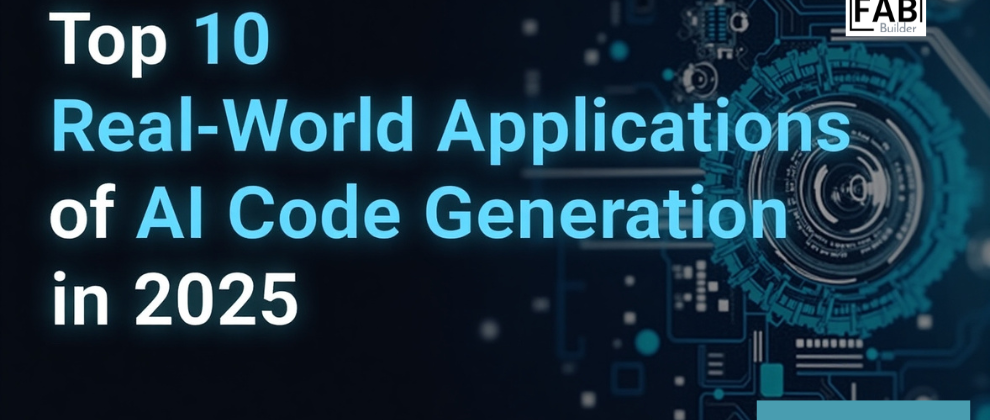Artificial Intelligence (AI) has transformed nearly every corner of the tech industry, and one of its most impactful contributions is AI Code Generation. From automating repetitive coding tasks to empowering developers with ready-to-use code snippets, AI has redefined the software development cycle. In 2025, the adoption of AI-powered code generators is no longer just an emerging trend — it has become a cornerstone of modern software engineering. Businesses, startups, and enterprises are now relying on AI tools to accelerate development, improve accuracy, and reduce costs.
In this blog, we’ll explore what AI Code Generation is, how it works, the leading tools in this space, and the top 10 real-world applications of AI Code Generation in 2025. We’ll also look at how platforms like FAB Studio are making coding more accessible and efficient for businesses of all sizes.
What is AI Code Generation?
AI Code Generation refers to the use of machine learning models, natural language processing (NLP), and large-scale training datasets to automatically write or suggest lines of code. Unlike traditional coding, where developers manually write logic, AI models understand natural language prompts or incomplete snippets and generate executable code.
For example, instead of spending hours building a login system from scratch, a developer can ask an AI code generator to create one in seconds. This doesn’t replace human programmers but augments their abilities by removing repetitive tasks and offering intelligent recommendations.
At its core, AI Code Generation is about:
Understanding human input (text-based instructions or pseudocode).
Mapping the request to a trained knowledge base of programming languages and frameworks.
Producing high-quality, context-aware code that can be deployed with minimal modifications.
How Does AI Code Generation Work?
AI Code Generation combines machine learning models with contextual understanding to deliver relevant code. Here’s a breakdown of how it works:
Input Stage: A developer provides an instruction, either in natural language (e.g., “Create a Python function to sort a list”) or partial code.
Processing Stage: The AI interprets the input using large language models (LLMs) trained on billions of lines of open-source and proprietary code. These models can identify patterns and best practices from multiple programming languages.
Code Generation Stage: The system generates output in the requested programming language, ensuring syntax correctness and logical flow. Some advanced code builders even include inline explanations for better understanding.
Feedback and Refinement: Developers can refine the request, and the AI adjusts accordingly. This iterative approach makes the generated code more accurate and aligned with project requirements.
In 2025, many code generation platforms also integrate debugging, unit testing, and optimization capabilities, ensuring the final product is not just functional but also efficient.
Tools and Platforms for AI Code Generation
Several AI-driven platforms dominate this space in 2025, offering everything from autocomplete features to full-stack application building. Some of the most widely used include:
GitHub Copilot: A pioneer in AI-assisted coding, built on OpenAI’s Codex model, helping developers generate snippets across multiple programming languages.
Tabnine: Known for AI-powered code completions tailored to enterprise environments.
Replit Ghostwriter: Offers real-time AI assistance for collaborative coding in the browser.
Amazon CodeWhisperer: Amazon’s solution integrated with AWS for building scalable applications.
Low-Code Platforms: Platforms like OutSystems, Mendix, and others that combine drag-and-drop functionality with AI-generated backend code.
And among these, platforms like FAB Studio are carving their own niche by offering a balanced combination of AI code generation, automation, and application development capabilities.
Top 10 Real-World Applications of AI Code Generation in 2025
Now, let’s dive into the real-world applications that are shaping industries today.
1. Accelerating Web and Mobile App Development
Startups and enterprises often struggle with time-to-market. AI Code Generation enables faster creation of web and mobile applications, generating both frontend UI components and backend logic. For instance, a developer can request a fully functional shopping cart in React, complete with payment gateway integration, in minutes.
2. Building Custom APIs
APIs are the backbone of digital connectivity, but writing one from scratch can be time-consuming. In 2025, AI-powered code generators allow developers to create secure, scalable, and well-documented APIs using a few prompts. This makes integration across apps and services faster and more reliable.
3. Automated Bug Fixing and Debugging
Debugging is one of the most frustrating parts of software development. Modern AI code generation platforms not only write code but also identify logical errors, suggest corrections, and even patch vulnerabilities automatically. This improves code quality and minimizes downtime.
4. Data Science and Machine Learning Workflows
AI-driven tools are heavily used in data science. They generate Python scripts, SQL queries, and machine learning pipelines to process and analyze massive datasets. For example, instead of manually coding feature engineering steps, an AI code builder can automatically create optimized data transformation pipelines.
5. Game Development Assistance
Game developers use AI-generated snippets to build mechanics, character behaviors, and even virtual environments. In 2025, AI generators help indie studios and large companies alike reduce development cycles while experimenting with creative gameplay ideas.
6. Enterprise Automation
Enterprises are adopting AI code generation to build workflow automations. From HR onboarding systems to financial reporting dashboards, these tools simplify repetitive business tasks by generating applications that are tailored to organizational needs.
7. Cloud Infrastructure Management
Managing cloud systems often requires writing Infrastructure as Code (IaC). AI tools can now generate Terraform scripts, Kubernetes configurations, or AWS CloudFormation templates in seconds. This ensures businesses scale infrastructure efficiently without relying on manual configurations.
8. Personalized Education Tools
In the education sector, AI is used to build custom learning management systems and interactive platforms. For instance, educators can create adaptive quizzes or personalized learning journeys with the help of AI-generated backend code.
9. Cybersecurity Applications
Security teams leverage AI code generation to create scripts for penetration testing, malware analysis, and automated monitoring. By generating code snippets for intrusion detection, these platforms strengthen enterprise security frameworks.
10. Prototyping and MVP Development
Perhaps the most popular application in 2025 is the creation of prototypes and Minimum Viable Products (MVPs). With AI, entrepreneurs can quickly validate their ideas by building functional demos at a fraction of the cost and time compared to traditional methods.
FAB Studio: A Modern Approach to AI Code Generation
While many platforms focus on AI-assisted coding, FAB Studio takes the concept further by blending AI Code Generation with a comprehensive application development platform. Designed as a low-code platform, FAB Studio empowers businesses and individuals to create robust applications without needing deep technical expertise.
What makes FAB Studio stand out is its ability to act as both a code generator and a code builder, giving developers and non-technical users flexibility. Whether you’re a startup founder looking to launch a mobile app or an enterprise aiming to automate workflows, FAB Studio reduces the development cycle drastically.
Its user-friendly environment allows drag-and-drop functionality while integrating AI-generated code on the backend. This hybrid approach ensures that even complex applications can be created seamlessly, making it a valuable tool for 2025’s fast-paced digital economy.
Benefits of AI Code Generation in 2025
As the adoption of AI grows, the benefits are becoming increasingly clear:
Speed: Development cycles shrink from months to weeks.
Cost-Effectiveness: Businesses save money by automating repetitive tasks.
Scalability: AI adapts to project needs, from small apps to enterprise-grade platforms.
Accessibility: Low-code platforms combined with AI code generation democratize app development, empowering non-programmers.
Innovation: By freeing developers from mundane coding, AI allows more focus on creativity and innovation.
Challenges of AI Code Generation
Despite its advantages, AI Code Generation is not without limitations. Some common challenges include:
Accuracy Issues: AI may sometimes produce inefficient or insecure code.
Dependence on Training Data: If the dataset lacks certain use cases, generated code may fall short.
Ethical Concerns: Intellectual property rights and licensing remain areas of debate when using AI-generated code.
Human Oversight: AI cannot replace human creativity or judgment. Final validation by skilled developers is still necessary.
Conclusion
In 2025, AI Code Generation has firmly established itself as a revolutionary force in software development. From accelerating app development to strengthening cybersecurity and simplifying enterprise workflows, its applications are vast and practical. Tools like GitHub Copilot, CodeWhisperer, and Replit continue to evolve, while platforms like FAB Studio redefine accessibility by merging AI with low-code development.
As businesses continue to embrace this technology, the future of coding will not be about replacing humans but empowering them. Developers will focus more on problem-solving and creativity, while AI takes care of repetitive and time-consuming tasks. The synergy of human ingenuity and machine intelligence promises a new era of innovation in the digital world.
FAQ
Q1. What is AI Code Generation?
AI Code Generation is the process of using artificial intelligence to automatically write, suggest, or optimize code based on natural language instructions or partial code inputs.
Q2. How does an AI code generator work?
An AI code generator uses machine learning models trained on large datasets of code. It understands prompts and generates contextually correct code snippets or entire applications.
Q3. Can AI Code Generation replace human developers?
No, AI cannot fully replace human developers. It enhances productivity by handling repetitive tasks, but human creativity, problem-solving, and oversight are still essential.
Q4. What are some real-world applications of AI Code Generation in 2025?
AI Code Generation is used in app development, debugging, API creation, cloud management, enterprise automation, and even cybersecurity applications.
Q5. What is FAB Studio, and how is it different from other platforms?
FAB Studio is a modern application development platform that combines low-code features with AI Code Generation. Unlike standard code generators, it empowers both developers and non-technical users to build robust applications quickly.







Top comments (0)